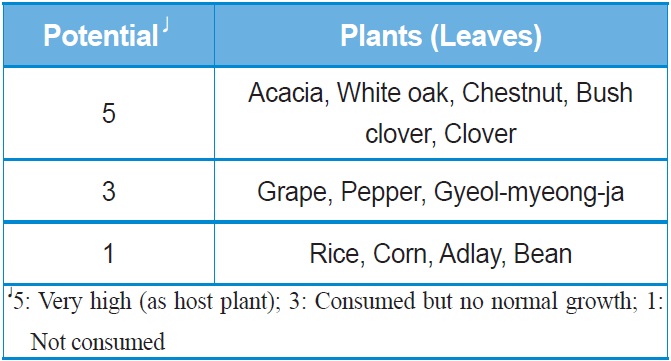



Insects can provide economic resources as pets, pollen vectors, natural enemies, food, or medical uses. Allomyrina dichotoma and Dorcus titanus are gorgeous beetles and popular pet insects in Korea, but industrial insect farmers require new, diverse pet insects as a source of income.
Stick insects are terrestrial phytophagous insects found in nearly all temperate and tropical ecosystems. Over 3000 species exist in the world, including 5 species in Korea. To avoid predators, they either play dead or try to scare the predator with a startle display such as leg kicking or spastic motion. Some species can purposely lose some of their legs to aid their escape from a predator’s grasp and can regenerate the lost limbs during successive molts; further, these species are popular as pets and as displays at zoological gardens (John, 2008). Their body color can change depending on the environmental conditions; in Carausius morosus, the body pigmentation can be affected by visual stimulation of its compound eyes (Detlef, 1977). Much research has been carried out on their oviposition behavior, maturation divisions of parthenogenesis, preying by spiders, and leg movements (Carlberg, 1984; Eva and Ulrich, 1985; Pijnacker, 1966; Wolfgang, 1990).
Baculum elongatum has a long, thin shape that resembles a twig, propagates by parthenogenesis, changes body color, and drops eggs, all of which suggests its potential in the commercial market, especially as an educational pet insect.
Thus, this study was carried out to determine the best hatching environment and an alternative or artificial diet for rearing
To investigate the characteristics of oviposition of
To investigate the hatch rate of
To investigate the hatch rate of
To investigate the hatch rate of
To investigate the developmental period and body length of insects of each stage, individual nymphs and adults were reared in rearing cages (20 × 15 × 15 cm) at 25 ± 1℃ and 65 ± 5% relative humidity under a photoperiod of light-dark (LD) 16:8 h. Insects were checked every day for hatching molting and mortality. The length of eggs and nymphs were measured under a stereomicroscope and using a ruler, respectively.
>
Alternative and artificial diet
To select an alternative diet, leaves of several plants were tested such as acacia, white oak, chestnut, bush clover, clover, grape, pepper, gyeolmyeong- ja, rice, corn, adlay, and bean. A nymph was reared on a diet of each test plant in the rearing room for 3 days. If the nymph ate the plant, then the test was continued. This was to determine whether the insects that consumed the test plant leaves developed
[Table 1.] Characteristics of oviposition of Baculum elongatum

Characteristics of oviposition of Baculum elongatum
to the next stage.
To develop an artificial diet, acacia leaf powder was used as the main host plant source and agar was used as the coagulating agent. Fresh acacia leaves were dried using a drier at 50℃ for 48 h and were ground into powder by using electric grinder. After boiling in 100 mL distilled water, 1, 2, of 3 g of agar corresponding to 1, 2, or 3% treatments, respectively were added and boiled for further 10 min. Leaf powder in the amount of 5, 10, 15, 20, of 25 g corresponding to 5, 10, 15, 20, or 25% treatments, respectively, were added and mixed along with several additives, including malt (14 g), yeast (7.5 g), vitamins (1.9 g), sorbic acid (0.3 g), salt mixture (1 g), ascorbic acid (1.9 g) and MPH (0.6 g).
The pre-oviposition and post-oviposition periods were 14.5 ± 2.2 and 1.4 ± 2.0 days, respectively, and their deviations were not high. The oviposition period and the number of eggs per female were 42.2 ± 22.7 days and 109.5 ± 70.5, respectively, with high deviations(Table 1). These results differed from that shown in a study where the oviposition period and number of eggs per female were 54.23 days and 60, respectively (Park et al., 2003).
The hatch rates of

Hatch rate(%) of Baculum elongatum after exposure to different durations of cold temperature
[Table 3.] Hatch rate of Baculum elongatum under different hatching conditions

Hatch rate of Baculum elongatum under different hatching conditions
[Table 4.] Hatch rate of Baculum elongatum under different temperatures

Hatch rate of Baculum elongatum under different temperatures
was 98.2% in the treatment comprising floral foam, fermented sawdust, and leaves and 92.0% in the treatment comprising the fermented sawdust, leaves (Table 3). The optimal temperature for hatching was approximately 20-25℃. In the 27.5 and 30℃ treatments, the hatch rate was very low (Table 4).
The developmental period of
[Table 5.] Developmental period and body length of each stage of Baculum elongatum

Developmental period and body length of each stage of Baculum elongatum
[Table 6.] Potential of alternative diet plants for Baculum elongatum

Potential of alternative diet plants for Baculum elongatum
>
Alternative and artificial diet

Rate of Baculum elongatum reaching adulthood when fed artificial diets of different media and leaf powder densities
acacia, white oak, chestnut, and bush clover (Table 6). It is known that acacia, white oak, chestnut, and bush clover are the host plants of
The rate of reaching adulthood for
The best results for hatching the eggs of







